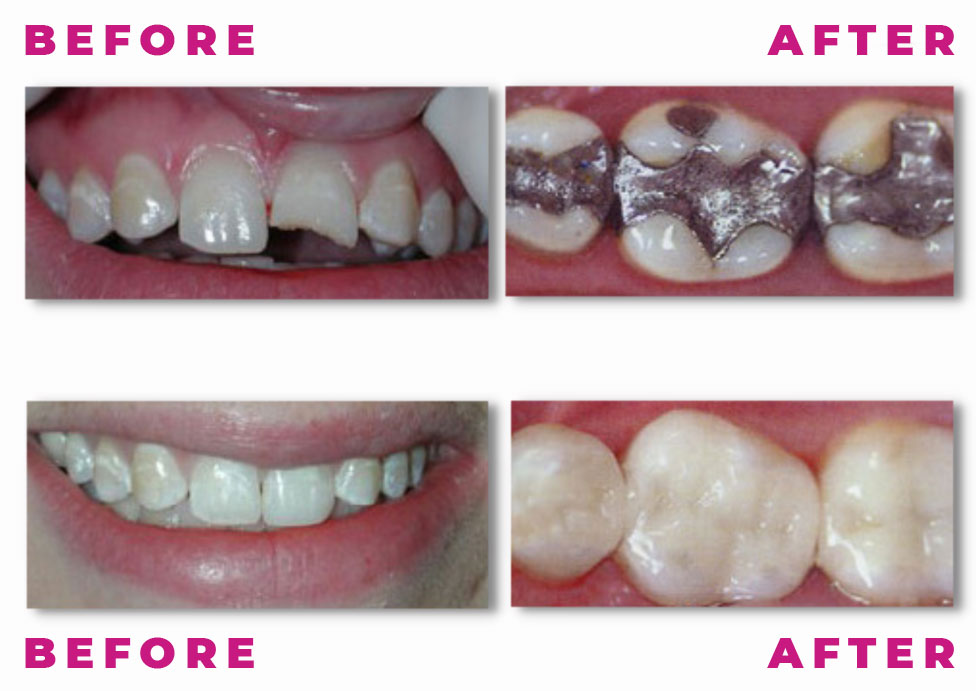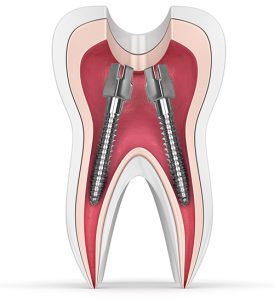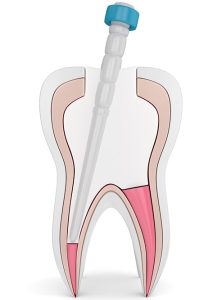Conservative dentistry
Conservative dentistry is a part of dentistry that is involved in the treatment of damaged teeth. It includes a wide range of interventions that the dentists of the Dr. Veselinović Dental Clinic apply on a daily basis.
What does conservative dentistry treat?
The most common diseases for which patients turn to the dentist are damage to the hard tissues of the teeth:
- caries;
- fracture;
- erosion;
- dental nerve inflammation, etc.
Conservative dentistry involves the application of the following methods:
- composite fillings;
- dental veneers;
- conservative tooth extension.
Thanks to the latest technologies, at the Dr. Veselinović Dental Clinic, we take care of both the function and the aesthetics of the dental foundation.
Considering this, we use the highest quality materials from eminent manufacturers.
Subfields of conservative dentistry
Conservative dentistry is divided into:
- restorative dentistry;
- endodontics.
Restorative dentistry
Restorative dentistry deals with the replacement of tooth tissue.
The causes that lead to the loss of dental tissue are different and impair the aesthetics and function of the teeth. Modern dentistry strives to preserve as much of the healthy tooth tissue as possible and return the tooth to its original shape.
In this direction, new methods, materials, instruments, and devices are being developed. Together, they help in choosing the appropriate therapy and achieving its quality and longevity.
What interventions belong to restorative dentistry?
Caries treatment
Caries is the most common dental disease that leads to the destruction of the hard tissues of the teeth. It is caused by the deposition of dental plaque bacteria.
Most people have encountered this problem at least once, and know how unpleasant it can be.
Initially, caries leads to hypersensitivity of the teeth to certain stimuli: hot, cold, and sweet. In later stages of development, it can be the cause of dental nerve (pulp) disease. If left untreated, it will certainly lead to tooth loss.
Tooth filling
After complete caries removal, the lack of dental tissue should be replaced. This is achieved by filling the teeth.
Please note that in the production of aesthetic fillings, we pay the same attention to front and side teeth. Our expertise in making fillings is achievable thanks to the nano-technology composite material of top foreign manufacturers 3M ESPE, ULTRADENT, GC, and SCHOFU.
We make aesthetic fillings respecting the standards of dental morphology, all intending to achieve the natural appearance of the teeth.
Today, white composite fillings are most often used for filling. They are much better in terms of chemical composition than amalgam (black) fillings that contain mercury.
In addition to the chemical, the physical characteristics of white fillings have been improved. This means that there is a large selection of shades, thus it is easy to choose the one that fits the natural color of the teeth. In this way, an extremely high aesthetic effect and a very positive impression are achieved.
 Thereby, it can be concluded that it is advisable to replace the old, black fillings with new, white ones.
Thereby, it can be concluded that it is advisable to replace the old, black fillings with new, white ones.
What sometimes causes concern is the sporadic hypersensitivity of the teeth after placing a new filling. Fortunately, this phenomenon is temporary.
In the case that the filling is high when in contact with the teeth of the opposite jaw, this is solved by grinding the excess filling. However, sometimes the reasons for the pain are more serious: the great proximity of the filling to the dental pulp (nerve).
It is important that, depending on the cause, the specialists of the Dr. Veselinović Dental Clinic use different methods and techniques to eliminate the given problem.
Endodontic treatment of teeth
Endodontic dental treatment refers to the treatment of the root canal of a tooth that is affected by an infection. A root canal infection can occur for several reasons. Those are:
- untreated caries;
- repeated interventions on the tooth;
- the existence of periodontal pockets;
- complications after dental trauma (injury).
Infections in the root canal spread further into the jawbone and soft tissues, leading to pain, swelling, and other conditions that accompany inflammation. Treatment of one or more root canals (in multi-rooted teeth) involves the removal of the pulp and mechanical cleaning of pathogenic microorganisms. After cleaning and rinsing, the canal is filled with special pastes and endodontic fiberglass stakes to keep the space inside the tooth hermetically sealed and the tooth root stable.
Thus, the possibility of the re-creation of inflammatory processes is eliminated. Root canal treatment with extraction of the dental nerve belongs to the group of least popular dental interventions due to the prejudice that it is a painful intervention. However, patients need not fear. Endodontic therapy is performed under local anesthesia and patients describe their experience as similar to filling teeth.
Conservative tooth extension
The success of endodontic treatment of teeth depends on the morphology of the teeth themselves, but also the degree of the inflammatory process. Lateral teeth require more involved because they have multiple interlaced dental canals that bifurcate and are often impassable. Extension or strengthening of healed teeth is necessary after root canal treatment because otherwise, the tooth would crack (fracture).
Conducting root canal therapy and creating access cavities can reduce the strength of the remaining tooth crown. Often, it is necessary to reinforce the crown and the root by placing posts inside the root canal of the tooth.
During this process, the potential fracture point of the tooth moves away from the gingival margin towards the apex of the root, which reduces the risk of fracture.
After placing the posts, crown reconstruction can be either intracoronal (inlay type) or extracoronal (crown). The placement of an extracoronal restoration significantly reduces stresses and prolongs the life of the tooth.
Great attention is required when preparing the cavity for the post. It must follow the shape and direction of the root canal, avoiding going laterally or damaging the filling of the apical part of the root.
Requirements for the reconstruction of non-vital teeth include:
- Long-term preservation of the remaining root.
- Easy placement.
- Resistance to masticatory stresses.
- Compatibility of the post with other restorative materials.
Types of Posts
A pulpal post represents an intraradicular restoration for a devitalized (“dead”) tooth and depends on the strength and integrity of the remaining tooth structure that retains it in place.
For the restoration of endodontically treated teeth, the following types of posts are used:
- Cast post and cores.
- Prefabricated metal posts.
- Fiberglass posts.
Cast post are not used as frequently as before because it has been found that cast posts, compared to prefabricated ones, cause three times more root fractures. Additionally, there is an issue with retaining the alloy in the canal.

Metal posts are used mostly in the restoration of multi-rooted lateral teeth, and even in teeth with divergent roots. They are easily applied and cemented.

Fiberglass posts – the most significant advantage of this type of posts is their modulus of elasticity, which is similar to the modulus of elasticity of dentin, leading to a more even distribution of stress on the tooth root. They have physical properties similar to dentin, achieve maximum retention with minimal removal of dentin from the root canal, do not disrupt the distribution of loads through the tooth structures, meet aesthetic requirements, and, most importantly, are easy to place in the root canal and cement.

Parapulpal posts are inserted into vital teeth (teeth with nerves) and can be:
- Metal
- Carbon
Their function is to strengthen the damaged coronal part of the tooth. They serve as reinforcement for the buildup with a light (white) filling. They can vary in diameter and length.
Conservative dentistry - Frequently asked questions
1. Should I replace the black fillings with white ones?
Yes, the specialists of the Dr. Veselinović Dental Clinic agree that this change should be made, and the explanation is stated above.
2. Is the dental treatment painful?
The answer to this question is negative. In order to eliminate possible doubts, we emphasize that under the term dental treatment we mean endodontic dental treatment – extraction (pulp) of the nerve and treatment of the tooth root canal.
At our clinic, this intervention (like many others) is performed under local anesthesia, which makes it painless and comfortable for the patient.
3. The entire crown of my tooth broke. Do I have to extract that tooth?
A tooth with a broken crown, but with a healthy root (without process – root tip disease), should be preserved.
We can only conclude the condition of the tooth based on a clinical and X-ray examination.
If the root requires it, treatment is started. The healed root can serve as the foundation for a new build-up and a new ceramic or composite crown.
4. Can a white filling look like a natural tooth?
The goal of every therapist who models a filling must be to satisfy the morphological characteristics of the tooth on which the filling is made. A properly modeled and defined filling will match the appearance of a natural, intact tooth.
5. I have a white filling on the front tooth, but a black mark appeared under the filling. What should I do?
In order to determine whether it is only a change in the color of the filling or whether secondary (new) caries have developed under it, the patient must come to our clinic for an examination. Based on the diagnosis, our doctors will determine the appropriate therapy.
6. I had my tooth treated and it turned black. What should I do?
During endodontic treatment, the pulp (nerve) is removed from the tooth, causing it to become a “dead” tooth.
Considering the fact that there is no longer a nerve through which it is supplied with the necessary nutrients, there is a possibility that such a tooth will change color, that is, darken.
If that tooth is located in the front region or is conspicuous, it is easiest to place a composite veneer on the front surface of that tooth.
A veneer can be made in just one visit to our dental office.
It is also possible to cover that tooth with a ceramic crown.
In certain situations, there is the possibility of whitening the tooth crown itself, which can achieve very good results.
7. I have just had a filing put on my tooth, and one part has broken soon after it. What happened?
There are several reasons why a new filling can crack. Some of them are non-compliance with the form of resistance and the form of retention, the occurrence of excessive trauma during chewing, etc.
If this happens, the patient should visit our office as soon as possible so that the problem can be remedied.
8. My tooth hurts when is in contact with something cold. What should I do?
In this case, it is necessary to contact our dentists, who will take an X-ray and clinically examine the tooth. Based on the findings, they will conclude whether the cause of the pain is receding gums, a periodontal pocket, caries, or something else. According to the diagnosis, he will prescribe the appropriate therapy.
9. I feel pain when I am chewing hard food. What should I do?
If the tooth hurts due to pressure, and it has been recently filled, the first thing that can be suspected is that it is too high, i.e. inadequately articulated filling.
As mentioned above, it can be solved very simply: by grinding the excess filling.
Another reason may be a disease of the teeth or the periodontium (the tissue around the teeth). The specialists of the Dr. Veselinović Dental Clinic will determine what the problem is and take all measures to eliminate the problem.



